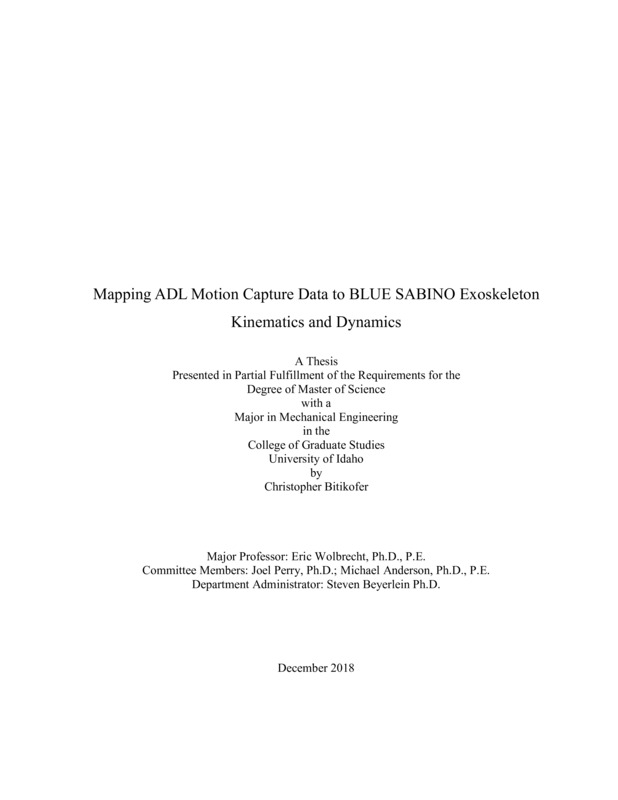Mapping ADL Motion Capture Data to BLUE SABINO Exoskeleton Kinematics and Dynamics
Bitikofer, Christopher Kerry. (2018-12). Mapping ADL Motion Capture Data to BLUE SABINO Exoskeleton Kinematics and Dynamics. Theses and Dissertations Collection, University of Idaho Library Digital Collections. https://www.lib.uidaho.edu/digital/etd/items/bitikofer_idaho_0089n_11470.html
- Title:
- Mapping ADL Motion Capture Data to BLUE SABINO Exoskeleton Kinematics and Dynamics
- Author:
- Bitikofer, Christopher Kerry
- ORCID:
- 0000-0003-0337-5468
- Date:
- 2018-12
- Embargo Remove Date:
- 2020-07-08
- Keywords:
- BLUE SABINO Dynamics Exoskeleton Inverse-Kinematics Kinematics Robotics
- Program:
- Mechanical Engineering
- Subject Category:
- Mechanical engineering; Robotics; Engineering
- Abstract:
-
The design of the powered upper-limb exoskeleton BLUE SABINO (BiLateral Upper-extremity Exoskeleton for Simultaneous Assessment of Biomechanical and Neuromuscular Output) (Trimble & Perry, 2016), requires selection of an optimal set of actuators and passive elastic elements, demanding knowledge of representative actuator angular position and torque distributions. This thesis describes determination of the distributions of BLUE SABINO joint-space angles and torques during expected use of the upper-limb corresponding to arm trajectories from a representative (i.e., normal) set of activities-of-daily-living (ADL) motions.
A motion-captured ADL dataset collected in an earlier study, (Perry, Powell, & Rosen, 2009), was mapped via inverse-kinematics (IK) from a Cartesian workspace to BLUE SABINO’s manipulator joint space to produce joint-space angle distributions. The explicit IK mapping was developed using vector analysis of a 9 degrees-of-freedom kinematic model of the upper-limb coupled to the 9 DOF kinematic model of BLUE SABINO. After IK mapping of the ADL trajectories, combined dynamic models of the upper-limb and BLUE SABINO were simulated using SimScape Multibody™ (a MathWorks™ product) along the joint-space trajectories to determine the corresponding torque trajectories. While the inverse kinematic mapping is complete for actuators 1 through 9, the available ADL data does not provide enough information to orient the wrist, and so position and torque distributions have only been established for actuators 1 through 6 at the time of writing. The remaining DOFs were stationary during dynamic simulation.
In total, 710 of 719 available ADL motion-capture recordings have been processed to generate joint-space angle and torque distributions. These distributions provide important information regarding actuation requirements and other design aspects of BLUE SABINO. For example, the angular position distributions inform the design of joint-space hard-stops. Additionally, the torque distributions confirm that the current set of selected actuators provides sufficient torque to actuate the exoskeleton. They also suggest that a gravity balance mechanism should be considered for actuator 3 (in addition to actuator 2). Future work, including additional analysis of the ADL joint-space dataset and utilization of the simulation tools developed in this work, will improve the design of BLUE SABINO.
- Description:
- masters, M.Engr., Mechanical Engineering -- University of Idaho - College of Graduate Studies, 2018-12
- Major Professor:
- Wolbrecht, Eric
- Committee:
- Perry, Joel; Anderson, Michael
- Defense Date:
- 2018-12
- Identifier:
- Bitikofer_idaho_0089N_11470
- Type:
- Text
- Format Original:
- Format:
- application/pdf
- Rights:
- In Copyright - Educational Use Permitted. For more information, please contact University of Idaho Library Special Collections and Archives Department at libspec@uidaho.edu.
- Standardized Rights:
- http://rightsstatements.org/vocab/InC-EDU/1.0/

